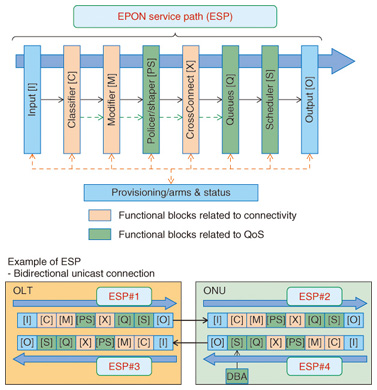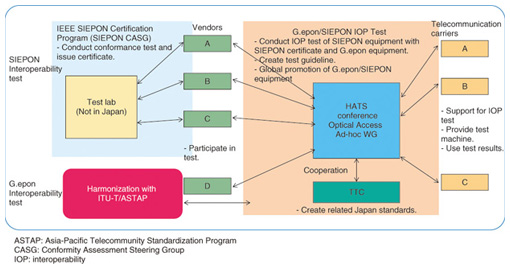 |
|||||||||||||||||
|
|
|||||||||||||||||
|
Global Standardization Activities Vol. 12, No. 1, pp. 58–63, Jan. 2014. https://doi.org/10.53829/ntr201401gls G.epon and Current Status of Related StandardizationAbstractG.epon is an ITU-T (International Telecommunication Union, Telecommunication Standardization Sector) version of the system-level EPON (Ethernet passive optical network) standard that uses generic OMCI (ONT (optical network terminal) management and control interface) in SIEPON (Service Interoperability in EPON) package B. It was given consent in July 2013 and approved in September 2013. This article reports on G.epon, which is expected to be deployed in emerging nations and developing countries, and explains the current status of related standardization. Keywords: EPON, SIEPON, OMCI 1. IntroductionThe use of optical access systems based on passive optical networks (PONs) has increased along with the expansion of broadband services. GE-PON*1, a type of EPON (Ethernet based PON), has been widely deployed in Japan. However, the scope of IEEE (Institute of Electrical and Electronics Engineers) EPON standardization has been limited to the PHY (physical) and MAC (media access control) layers and other system specifications that depended on implementations by system vendors or telecommunication carriers to provide their services. The scope of IEEE 802.3 [1] standardization using the layer model of the EPON system is shown in Fig. 1. There is no specification of higher layers in IEEE 802.3 standardization, as shown in the figure, so telecommunication carriers desiring system deployment in multivendor environments require additional development or modification of firmware and hardware. Moreover, system vendors have had difficulty doing business globally because they could not ensure that their systems would be interoperable with other systems even if they had been developed in compliance with IEEE standards. In view of these situations, IEEE initiated system-level EPON standardization in order to ensure the interoperability between optical line terminals (OLTs) and optical network units (ONUs). That standardization was approved in June 2013 [2]. By contrast, the trend to introduce de jure standards in developing countries and emerging nations has become an issue that must be addressed in the global promotion of EPON. In view of the fact that future networks were expected to be packet-oriented, we began proposing that the International Telecommunication Union, Telecommunication Standardization Sector (ITU-T) create EPON standards through the Full Service Access Network (FSAN) [3] in 2001, when IEEE started work on EPON standardization. However, this proposal was not realized. Consequently, a variety of EPON systems with different specifications were developed. We have continued to seek a way to create EPON standardization in ITU-T ever since then. By contrast, IEEE started SIEPON*2 standardization, which is a system-level EPON standard, in 2010. We decided to grab this SIEPON standardization opportunity to work on G.epon standardization in order to incorporate a full set of specifications of widely used EPON systems into ITU-T standardization. To make a breakthrough in EPON standardization in ITU-T, we focused on SIEPON package B for G.epon standardization in the Japanese market and aimed for early completion of G.epon standardization. We took into consideration the future replacement (or coexistence) with G-PON and decided to apply OMCI (ONT (optical network terminal) management and control interface), which is widely used in ITU-T standards, to G.epon. The G.epon standard was given consent in July 2013 and approved in September 2013. This article reports on ITU-T G.epon and the current status of related standardization.
2. Overview of ITU-T Recommendation G.epon (G.9801)2.1 SIEPON standardization and G.eponI briefly introduce SIEPON standardization as a reference document of G.epon. SIEPON is intended to realize service interoperability among 1G-EPON or 10G-EPON equipment. In order to achieve this, the SIEPON standard specifies a system-level EPON standard that consists of three specification packages according to the market (Package A: North American MSOs (multiple system operators); Package B: Japan; Package C: China). The difference between G.epon and SIEPON in terms of constituent standards and principal functions is shown in Fig. 2. G.epon is an ITU-T version of the EPON standard specified by applying OMCI, which is widely used in ITU-T standards, to SIEPON package B. That standardization is being done under a Japanese initiative as a part of the Telecommunication Technology Committee (TTC)’s [4] upstream activity. On the contrary, SIEPON uses extended operations, administration, and maintenance (eOAM). However, hardware commonalization between G.epon and SIEPON compliant systems is anticipated because OAM functions can be realized with firmware. The principal functions newly specified in G.epon/SIEPON standards are listed in Table 1. Because the existing EPON standards did not specify these functions, it was difficult to realize interoperability even with standard-compliant devices.
2.2 Architecture model for G.epon/SIEPONThe architecture model for G.epon/SIEPON is shown in Fig. 3. The architecture model defines Line OLT/Line ONU having functions covered by the IEEE 802.3 standards, Client OLT/Client ONU having functions covered by G.epon/SIEPON standards, and Service OLT/Service ONU having additional functions for specific services provided by the communication carrier or system vendors. Moreover, the architecture model newly defines OLT_CI/ONU_CI as logical interfaces on the core network/user network side of Client OLT/Client ONU and OLT_LI/ONU_LI as a logical interface on the core network/user network side of Line OLT/Line ONU.
2.3 Logical function model for G.epon/SIEPONThe logical function model for G.epon/SIEPON is shown in Fig. 4. G.epon/SIEPON defines ESPs (EPON service paths), which provide basic functional blocks of the MAC client model to achieve provisioning, connection, and QoS in services. The basic functional blocks (input/output, classifier, modifier, policer, cross-connect, packet queue, and scheduler) in ESPs provide data forwarding in OLTs and ONUs. A set of ESPs in an OLT and an ONU represents a unidirectional connection. The example in this figure shows ESP configurations for the bidirectional unicast connection between an OLT and an ONU. The ESP concept is intended to be of help in understanding standard specifications because it simplifies and conceptualizes behaviors of MAC client functions, thus absorbing implementation differences such as single LLID (logical link ID) and multiple LLID configurations.
3. Status of G.epon-related standardizationThis section describes the current status of G.epon-related standardization. 3.1 Interoperability test specifications for G.eponA proposal to standardize a G.epon implementers’ guide was accepted in the ITU-T SG15/Q2 (Study Group 15; Question 2) interim meeting in February 2013. The G.epon implementers’ guide is intended to develop two kinds of test specifications for a conformance test, which is conducted by connecting an ONU under test to an OLT emulator, and an interoperability test, which is conducted by connecting one or multiple ONUs to an OLT in a multi-vendor environment. The IEEE 1904.1 WG is working on developing specifications for a conformance test (IEEE P1904.1 SIEPON/Conformance) that is performed by connecting an OLT and an ONU to an ONU emulator and OLT emulator, respectively. Although there are differences in each test configuration, the G.epon implementers’ guide is being developed in reference to SIEPON/Conformance standard documents. The development of the implementers’ guide is expected to be done through a Japanese initiative as part of upstream activities in TTC in common with G.epon. 3.2 Interoperability tests in JapanThe development of the G.epon implementers’ guide and SIEPON/Conformance have accelerated the movement to carry out EPON interoperability tests in Japan. Various organizations are cooperating in the interoperability tests, as shown in Fig. 5. The Optical Access Ad-hoc WG was established in the HATS (Harmonization of Advanced Telecommunication Systems) conference [5] of Japan in August 2012. This WG is an operating organization for conducting interoperability tests of G.epon/SIEPON compliant equipment. Hereafter, the Optical Access Ad-hoc WG is expected to conduct interoperability tests in cooperation with the SIEPON certificate program and TTC.
4. Future perspectivesThis article reported on G.epon, which was given consent this July, and the status of related standardization. G.epon is an ITU-T version of the EPON standard based on SIEPON package B for the Japanese market, which uses generic OMCI*3 instead of eOAM. G.epon is expected to be deployed in emerging nations and developing countries that place importance on de jure standards. The development of the G.epon implementers’ guide, which is a reference document for interoperability tests, and the corresponding movement to carry out interoperability tests in Japan are expected to accelerate activities related to interoperability test for G.epon and SIEPON. Moreover, successful G.epon standardization is expected to promote further cooperation between ITU-T and IEEE such as IEEE’s request to issue an ITU-T Recommendation number for the entire SIEPON standard including all packages.
References
|
|||||||||||||||||







